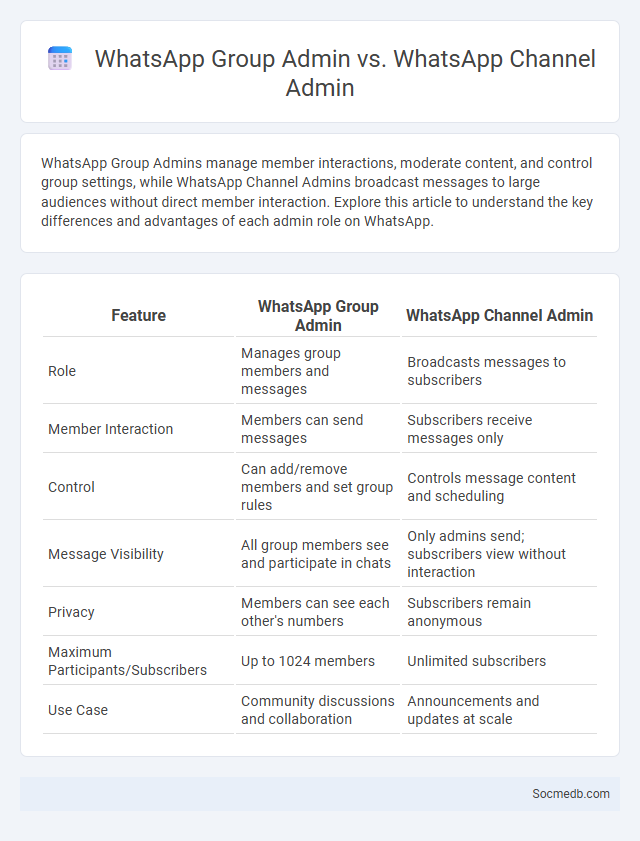
Photo illustration: WhatsApp Group Admin vs WhatsApp Channel Admin
WhatsApp Group Admins manage member interactions, moderate content, and control group settings, while WhatsApp Channel Admins broadcast messages to large audiences without direct member interaction. Explore this article to understand the key differences and advantages of each admin role on WhatsApp.
Table of Comparison
| Feature | WhatsApp Group Admin | WhatsApp Channel Admin |
|---|---|---|
| Role | Manages group members and messages | Broadcasts messages to subscribers |
| Member Interaction | Members can send messages | Subscribers receive messages only |
| Control | Can add/remove members and set group rules | Controls message content and scheduling |
| Message Visibility | All group members see and participate in chats | Only admins send; subscribers view without interaction |
| Privacy | Members can see each other's numbers | Subscribers remain anonymous |
| Maximum Participants/Subscribers | Up to 1024 members | Unlimited subscribers |
| Use Case | Community discussions and collaboration | Announcements and updates at scale |
Understanding WhatsApp Groups and Channels
WhatsApp Groups and Channels serve distinct purposes in social media communication, with Groups facilitating interactive conversations among members and Channels offering one-way broadcasts to a large audience. Groups enable real-time messaging, media sharing, and collaborative discussions, making them ideal for close-knit communities or project teams. Channels focus on disseminating information efficiently, allowing administrators to share updates, news, and content without direct interaction from subscribers.
Roles and Responsibilities of a WhatsApp Group Admin
A WhatsApp group admin manages member permissions, approves or removes participants, and enforces group rules to maintain a respectful and organized environment. They facilitate communication by sharing important updates, resolving conflicts, and ensuring messages align with the group's purpose. Admins also monitor content to prevent spam or inappropriate behavior, safeguarding the group's integrity and user experience.
Key Functions of a WhatsApp Channel Admin
A WhatsApp Channel Admin manages content distribution by curating and sharing updates directly with subscribers, ensuring messages are relevant and timely. They control subscriber access and communication settings, maintaining the channel's integrity and user experience. Your role includes monitoring interactions and moderating discussions to foster a safe and engaging community environment.
Group Admin vs Channel Admin: Core Differences
Group Admins manage member interactions, moderate content, and facilitate discussions within social media groups to foster community engagement. Channel Admins primarily control content broadcasting, focusing on one-way communication without member interaction or moderation responsibilities. The core difference lies in Groups promoting interactive collaboration, while Channels emphasize content dissemination to a passive audience.
Permissions and Controls: WhatsApp Group Admin
WhatsApp group admins hold key permissions that include adding or removing members, changing group information, and managing message settings such as who can send messages. These controls empower admins to maintain group order and privacy by restricting participant abilities and monitoring content. Admins also control group descriptions and can designate other admins, ensuring efficient governance and enhanced security within the WhatsApp group.
Permissions and Controls: WhatsApp Channel Admin
WhatsApp Channel Admins have precise permissions and controls to manage content, members, and privacy settings effectively, ensuring secure and organized communication. Your ability to moderate messages, control member access, and set channel guidelines maintains a safe environment and enhances user experience. These robust administrative features empower you to oversee and customize your WhatsApp channel with full authority and flexibility.
Managing Members: Groups vs Channels
Managing members in social media platforms varies significantly between groups and channels. Groups prioritize interactive member engagement, allowing members to post, comment, and collaborate, fostering community-building and discussion. Channels focus on one-way communication, where administrators broadcast content to subscribers with limited direct member interaction, optimizing information dissemination for large audiences.
Security Features for Admins
Social media platforms implement robust security features for admins, including multi-factor authentication (MFA) to prevent unauthorized access and role-based access controls (RBAC) to manage permissions effectively. Activity logs and real-time alerts enhance monitoring capabilities by tracking changes and suspicious activities, ensuring swift responses to potential threats. Encryption of data and secure API integrations further protect sensitive information and maintain platform integrity.
Best Practices for WhatsApp Admins
Effective WhatsApp admins manage group settings by enabling admin-only messages to maintain order and reduce spam. They establish clear guidelines for group behavior and consistently monitor conversations to foster respectful and relevant interactions. Utilizing pinned messages for important announcements enhances communication and ensures all members stay informed.
Choosing the Right Admin Role for Your Community
Selecting the appropriate admin role for your social media community ensures efficient management and clear responsibility distribution, enhancing user engagement and content moderation. Roles such as moderator, content creator, or analyst each offer unique benefits tailored to community size and goals. Defining these roles precisely supports seamless collaboration and helps maintain a positive, organized online environment.
 socmedb.com
socmedb.com